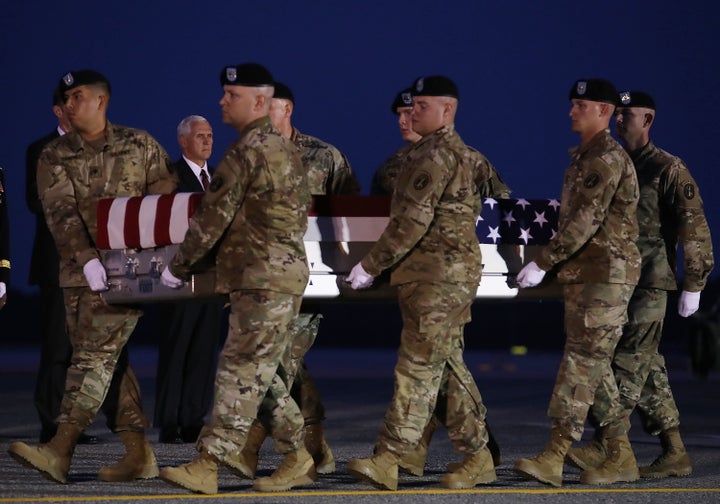
Three U.S. soldiers were killed and a fourth wounded in Afghanistan’s Nangarhar province this month, their killer an Afghan commando whom the Taliban claimed (less than credibly) was acting on its command. The Americans were young, the oldest among them not yet 30, and the youngest, one Corporal Dillon C. Baldridge of North Carolina, just 22.
Baldridge would have been in first grade when the 9/11 attacks happened, all of six years old when the United States invaded Afghanistan in 2001. The conflict in which Cpl. Baldridge died raged through most of his childhood and the entirety of his brief adult life—and for most of that time, it was forgotten or ignored by a political establishment that insists this, our longest war and nation-building project, is necessary to keep our country safe.
The death of Baldridge and too many others like him demands a reexamination of that claim.
The price this war exacts, the steady stream of blood and treasure it leaches year over year, is too high to accept unquestioned. Through three consecutive presidencies, the bipartisan assumption has been that the U.S. military must occupy and police vast swaths of land in Afghanistan (and elsewhere in the Mideast), and that it must do so in perpetuity.
What if that isn’t true? Let’s examine the evidence. After 16 years, what has the war in Afghanistan accomplished and at what cost?
Afghanistan in 2017 is a country in intractable turmoil. Its government, such as it is, ranks near the bottom of global standards in basic functions like enforcing contracts and issuing permits. Civilian casualties continue at devastating rates, which makes it unsurprising that more than 660,000 Afghans fled their homes to escape violence in 2016 alone, contributing to the ongoing and little-attended Afghan refugee crisis.
Worse yet, a stubborn Taliban insurgency controls at least 40 percent of Afghan territory, and by some estimates, that figure may be as high as 90 percent, cities excluded. But the Taliban and al Qaeda aren’t Afghanistan’s only terrorist infestations anymore: The Islamic State has surged in to take advantage of the chaos endless conflict has fostered. The reason that Taliban claim of responsibility for the casualties on Saturday isn’t entirely convincing is ISIS has become the primary threat in the region where the attack occurred.
This thoroughgoing failure was bought at an enormous price: tens of thousands of American and Afghan casualties and trillions in U.S. tax dollars and additions to the national debt. In Afghanistan, Washington has spent more money, adjusted for inflation, than it spent on the Marshall Plan that rebuilt Western Europe. Our children will pay interest on this fiasco. Perhaps our grandchildren’s taxes may begin to touch the principal.
The Afghan war “is now the longest in U.S. history—having lasted longer than the Civil War, World War I, and World War II combined,” notes Ret. Col. Andrew Bacevich, a military historian. The questions he raises should have been raised years ago: Why has this war and the broader “war on terror failed to result in even a single real success anywhere in the Greater Middle East? Could it be that we’ve taken the wrong approach?”
It could indeed. A decade and a half of experience more than demonstrates it is unrealistic and impractical to expect a foreign military—even the most powerful and well-funded military in the world by several orders of magnitude—to impose stability on Afghanistan. No occupying force can sweep every cave, clear every valley, re-build every village across more than 250,000 square miles. More to the point, no occupying force can make an external military solution fit what is primarily an internal political problem. Afghanistan can only be “fixed” by Afghans.
That context is what President Trump’s plan to once again hike U.S. troop levels in Afghanistan by about 4,000 soldiers so troubling. This impulse to double (well, triple) down on proven failure is inexcusably reckless and callously naïve. It will endanger more Americans like Cpl. Baldridge and prolong Afghan civilians’ suffering while producing no clear gains for U.S. security.
“Alternatives to open-ended war waged on the other side of the globe do exist,” as Bacevich has argued elsewhere. “Protecting Americans from the relatively modest threat posed by the Taliban or Al Qaeda or Islamic State—or all three combined for that matter—does not require the permanent stationing of U.S. forces in the Islamic world, especially given the evidence that the presence of American troops there serves less to pacify than to provoke.”
This proposed surge or maintenance of the failed status quo in Afghanistan are neither our best nor our only options. Trump should abort the push to escalate and explore a new strategy that prioritizes vital American security interests and eschews Sisyphean tasks of policing and nation-building Afghanistan.
